基于银行大数据的用户信用风险预测模型
- 格式:pdf
- 大小:947.15 KB
- 文档页数:11
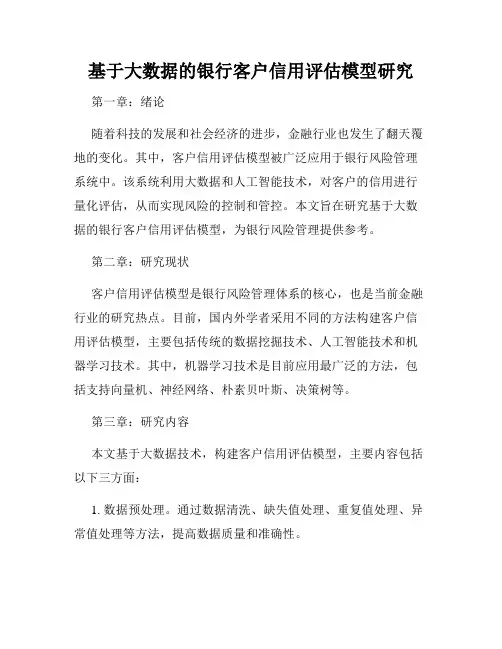
基于大数据的银行客户信用评估模型研究第一章:绪论随着科技的发展和社会经济的进步,金融行业也发生了翻天覆地的变化。
其中,客户信用评估模型被广泛应用于银行风险管理系统中。
该系统利用大数据和人工智能技术,对客户的信用进行量化评估,从而实现风险的控制和管控。
本文旨在研究基于大数据的银行客户信用评估模型,为银行风险管理提供参考。
第二章:研究现状客户信用评估模型是银行风险管理体系的核心,也是当前金融行业的研究热点。
目前,国内外学者采用不同的方法构建客户信用评估模型,主要包括传统的数据挖掘技术、人工智能技术和机器学习技术。
其中,机器学习技术是目前应用最广泛的方法,包括支持向量机、神经网络、朴素贝叶斯、决策树等。
第三章:研究内容本文基于大数据技术,构建客户信用评估模型,主要内容包括以下三方面:1. 数据预处理。
通过数据清洗、缺失值处理、重复值处理、异常值处理等方法,提高数据质量和准确性。
2. 特征选择。
采用特征选择算法,从海量数据中筛选出与客户信用相关性更高的特征,提高模型的预测精度。
3. 模型构建。
选取多种机器学习模型比较和优化,构建客户信用评估模型。
通过对比不同算法的精度和效率,确定最优算法,并将其应用于实际项目中。
第四章:研究方法在该模型构建过程中,我们采用了以下方法:1. 数据收集:通过银行内部系统、第三方数据、互联网数据等多渠道收集客户信息。
2. 数据预处理:对收集到的数据进行清洗、处理、对齐、加工等工作,提高数据质量和准确性。
3. 特征工程:在数据预处理的基础上,选取适当的特征,采用多种特征选取算法确定有意义的特征。
4. 模型构建:选取SVM、决策树、朴素贝叶斯等多种机器学习算法,比较并确定最优算法。
5. 验证和评估:对构建好的客户信用评估模型进行评估和验证,测试模型的预测精度和效率。
6. 风险控制:将应用于实际风险管理系统,使模型能够在实际环境中不断学习和优化,实现风险的控制和管控。
第五章:实验结果通过模型的构建和优化,我们比较了SVM、决策树、朴素贝叶斯等多种算法的精度和效率。
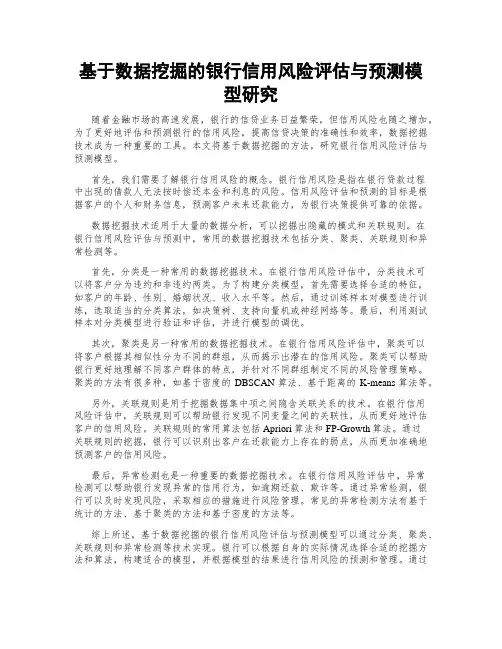
基于数据挖掘的银行信用风险评估与预测模型研究随着金融市场的高速发展,银行的信贷业务日益繁荣,但信用风险也随之增加。
为了更好地评估和预测银行的信用风险,提高信贷决策的准确性和效率,数据挖掘技术成为一种重要的工具。
本文将基于数据挖掘的方法,研究银行信用风险评估与预测模型。
首先,我们需要了解银行信用风险的概念。
银行信用风险是指在银行贷款过程中出现的借款人无法按时偿还本金和利息的风险。
信用风险评估和预测的目标是根据客户的个人和财务信息,预测客户未来还款能力,为银行决策提供可靠的依据。
数据挖掘技术适用于大量的数据分析,可以挖掘出隐藏的模式和关联规则。
在银行信用风险评估与预测中,常用的数据挖掘技术包括分类、聚类、关联规则和异常检测等。
首先,分类是一种常用的数据挖掘技术。
在银行信用风险评估中,分类技术可以将客户分为违约和非违约两类。
为了构建分类模型,首先需要选择合适的特征,如客户的年龄、性别、婚姻状况、收入水平等。
然后,通过训练样本对模型进行训练,选取适当的分类算法,如决策树、支持向量机或神经网络等。
最后,利用测试样本对分类模型进行验证和评估,并进行模型的调优。
其次,聚类是另一种常用的数据挖掘技术。
在银行信用风险评估中,聚类可以将客户根据其相似性分为不同的群组,从而揭示出潜在的信用风险。
聚类可以帮助银行更好地理解不同客户群体的特点,并针对不同群组制定不同的风险管理策略。
聚类的方法有很多种,如基于密度的DBSCAN算法、基于距离的K-means算法等。
另外,关联规则是用于挖掘数据集中项之间隐含关联关系的技术。
在银行信用风险评估中,关联规则可以帮助银行发现不同变量之间的关联性,从而更好地评估客户的信用风险。
关联规则的常用算法包括Apriori算法和FP-Growth算法。
通过关联规则的挖掘,银行可以识别出客户在还款能力上存在的弱点,从而更加准确地预测客户的信用风险。
最后,异常检测也是一种重要的数据挖掘技术。
在银行信用风险评估中,异常检测可以帮助银行发现异常的信用行为,如逾期还款、欺诈等。
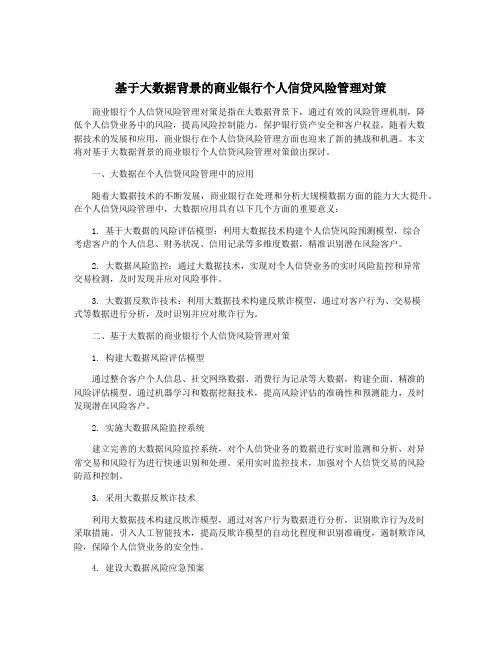
基于大数据背景的商业银行个人信贷风险管理对策商业银行个人信贷风险管理对策是指在大数据背景下,通过有效的风险管理机制,降低个人信贷业务中的风险,提高风险控制能力,保护银行资产安全和客户权益。
随着大数据技术的发展和应用,商业银行在个人信贷风险管理方面也迎来了新的挑战和机遇。
本文将对基于大数据背景的商业银行个人信贷风险管理对策做出探讨。
一、大数据在个人信贷风险管理中的应用随着大数据技术的不断发展,商业银行在处理和分析大规模数据方面的能力大大提升。
在个人信贷风险管理中,大数据应用具有以下几个方面的重要意义:1. 基于大数据的风险评估模型:利用大数据技术构建个人信贷风险预测模型,综合考虑客户的个人信息、财务状况、信用记录等多维度数据,精准识别潜在风险客户。
2. 大数据风险监控:通过大数据技术,实现对个人信贷业务的实时风险监控和异常交易检测,及时发现并应对风险事件。
3. 大数据反欺诈技术:利用大数据技术构建反欺诈模型,通过对客户行为、交易模式等数据进行分析,及时识别并应对欺诈行为。
二、基于大数据的商业银行个人信贷风险管理对策1. 构建大数据风险评估模型通过整合客户个人信息、社交网络数据、消费行为记录等大数据,构建全面、精准的风险评估模型。
通过机器学习和数据挖掘技术,提高风险评估的准确性和预测能力,及时发现潜在风险客户。
2. 实施大数据风险监控系统建立完善的大数据风险监控系统,对个人信贷业务的数据进行实时监测和分析,对异常交易和风险行为进行快速识别和处理。
采用实时监控技术,加强对个人信贷交易的风险防范和控制。
3. 采用大数据反欺诈技术利用大数据技术构建反欺诈模型,通过对客户行为数据进行分析,识别欺诈行为及时采取措施。
引入人工智能技术,提高反欺诈模型的自动化程度和识别准确度,遏制欺诈风险,保障个人信贷业务的安全性。
4. 建设大数据风险应急预案制定针对不同风险情景的应急预案,利用大数据技术进行风险预警和预测,有效应对突发风险事件,保障个人信贷业务的稳健经营。
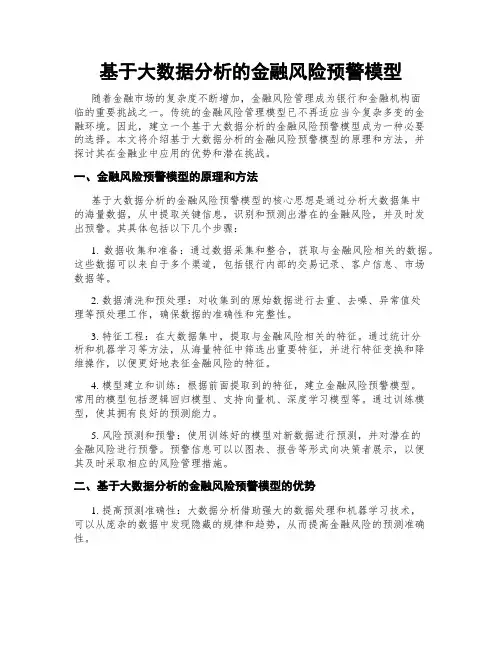
基于大数据分析的金融风险预警模型随着金融市场的复杂度不断增加,金融风险管理成为银行和金融机构面临的重要挑战之一。
传统的金融风险管理模型已不再适应当今复杂多变的金融环境。
因此,建立一个基于大数据分析的金融风险预警模型成为一种必要的选择。
本文将介绍基于大数据分析的金融风险预警模型的原理和方法,并探讨其在金融业中应用的优势和潜在挑战。
一、金融风险预警模型的原理和方法基于大数据分析的金融风险预警模型的核心思想是通过分析大数据集中的海量数据,从中提取关键信息,识别和预测出潜在的金融风险,并及时发出预警。
其具体包括以下几个步骤:1. 数据收集和准备:通过数据采集和整合,获取与金融风险相关的数据。
这些数据可以来自于多个渠道,包括银行内部的交易记录、客户信息、市场数据等。
2. 数据清洗和预处理:对收集到的原始数据进行去重、去噪、异常值处理等预处理工作,确保数据的准确性和完整性。
3. 特征工程:在大数据集中,提取与金融风险相关的特征。
通过统计分析和机器学习等方法,从海量特征中筛选出重要特征,并进行特征变换和降维操作,以便更好地表征金融风险的特征。
4. 模型建立和训练:根据前面提取到的特征,建立金融风险预警模型。
常用的模型包括逻辑回归模型、支持向量机、深度学习模型等。
通过训练模型,使其拥有良好的预测能力。
5. 风险预测和预警:使用训练好的模型对新数据进行预测,并对潜在的金融风险进行预警。
预警信息可以以图表、报告等形式向决策者展示,以便其及时采取相应的风险管理措施。
二、基于大数据分析的金融风险预警模型的优势1. 提高预测准确性:大数据分析借助强大的数据处理和机器学习技术,可以从庞杂的数据中发现隐藏的规律和趋势,从而提高金融风险的预测准确性。
2. 实时监控和预警:传统的风险管理模型通常是基于历史数据进行建模和分析,无法及时监控和预警金融风险。
而基于大数据分析的模型能够实时处理大量的数据,并及时发出风险预警信息。
3. 移动端应用:基于大数据分析的金融风险预警模型可以在移动设备上进行应用。
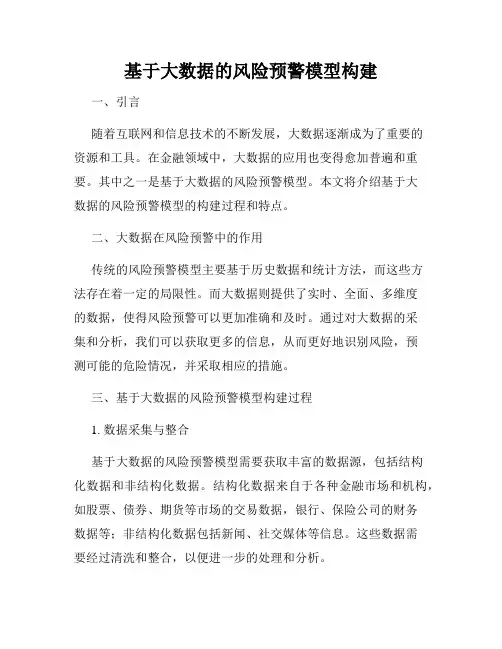
基于大数据的风险预警模型构建一、引言随着互联网和信息技术的不断发展,大数据逐渐成为了重要的资源和工具。
在金融领域中,大数据的应用也变得愈加普遍和重要。
其中之一是基于大数据的风险预警模型。
本文将介绍基于大数据的风险预警模型的构建过程和特点。
二、大数据在风险预警中的作用传统的风险预警模型主要基于历史数据和统计方法,而这些方法存在着一定的局限性。
而大数据则提供了实时、全面、多维度的数据,使得风险预警可以更加准确和及时。
通过对大数据的采集和分析,我们可以获取更多的信息,从而更好地识别风险,预测可能的危险情况,并采取相应的措施。
三、基于大数据的风险预警模型构建过程1. 数据采集与整合基于大数据的风险预警模型需要获取丰富的数据源,包括结构化数据和非结构化数据。
结构化数据来自于各种金融市场和机构,如股票、债券、期货等市场的交易数据,银行、保险公司的财务数据等;非结构化数据包括新闻、社交媒体等信息。
这些数据需要经过清洗和整合,以便进一步的处理和分析。
2. 特征提取与选择经过数据整合后,接下来需要从大量的数据中提取出有效的特征来建立模型。
特征提取是通过对数据进行综合分析和挖掘,找到与风险相关的指标和变量。
同时,为了提高模型的准确性和效率,还需要进行特征选择,去除冗余和无关的特征。
3. 模型建立与训练在特征提取和选择完成后,需要选择合适的算法和模型来建立风险预警模型。
常用的模型包括神经网络、支持向量机、随机森林等。
这些模型需要经过参数调整和训练来适应具体的风险预警需求。
模型建立和训练是一个迭代的过程,通过不断地优化和测试,提高模型的准确性和稳定性。
4. 风险评估与预测在模型建立和训练完成后,就可以进行风险评估和预测。
通过对新数据的输入和处理,模型可以对未来可能出现的风险进行预测,并给出相应的预警和建议。
同时,风险评估还需要考虑风险的程度、可行性和影响范围,给出相应的优先级和措施。
四、基于大数据的风险预警模型的特点1. 实时性和灵活性基于大数据的风险预警模型可以实时获取最新的数据,并及时更新模型,从而实现对风险的实时监控和预测。
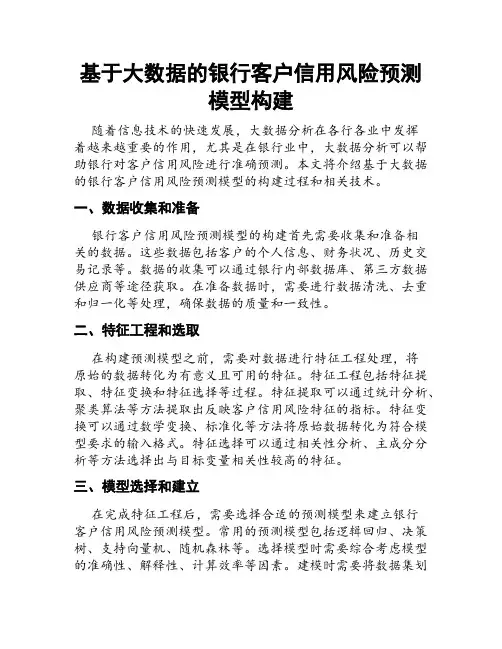
基于大数据的银行客户信用风险预测模型构建随着信息技术的快速发展,大数据分析在各行各业中发挥着越来越重要的作用,尤其是在银行业中,大数据分析可以帮助银行对客户信用风险进行准确预测。
本文将介绍基于大数据的银行客户信用风险预测模型的构建过程和相关技术。
一、数据收集和准备银行客户信用风险预测模型的构建首先需要收集和准备相关的数据。
这些数据包括客户的个人信息、财务状况、历史交易记录等。
数据的收集可以通过银行内部数据库、第三方数据供应商等途径获取。
在准备数据时,需要进行数据清洗、去重和归一化等处理,确保数据的质量和一致性。
二、特征工程和选取在构建预测模型之前,需要对数据进行特征工程处理,将原始的数据转化为有意义且可用的特征。
特征工程包括特征提取、特征变换和特征选择等过程。
特征提取可以通过统计分析、聚类算法等方法提取出反映客户信用风险特征的指标。
特征变换可以通过数学变换、标准化等方法将原始数据转化为符合模型要求的输入格式。
特征选择可以通过相关性分析、主成分分析等方法选择出与目标变量相关性较高的特征。
三、模型选择和建立在完成特征工程后,需要选择合适的预测模型来建立银行客户信用风险预测模型。
常用的预测模型包括逻辑回归、决策树、支持向量机、随机森林等。
选择模型时需要综合考虑模型的准确性、解释性、计算效率等因素。
建模时需要将数据集划分为训练集和测试集,通过训练集训练模型、通过测试集评估模型的准确性。
四、模型优化和验证在建立模型之后,需要对模型进行优化和验证,以提高其预测准确性和稳定性。
模型优化可以通过参数调整、特征选择和模型融合等方法进行。
模型验证可以通过交叉验证、ROC曲线、混淆矩阵等方法评估模型的性能。
同时,还需要进行模型的稳定性测试和验证,确保模型能够在新数据上具有良好的泛化性能。
五、模型应用和监控在完成模型的构建和优化后,需要将模型应用于实际的信用风险预测中。
银行可以根据模型的预测结果对客户进行信用评估,并根据评估结果决定是否提供贷款、信用卡等金融服务。
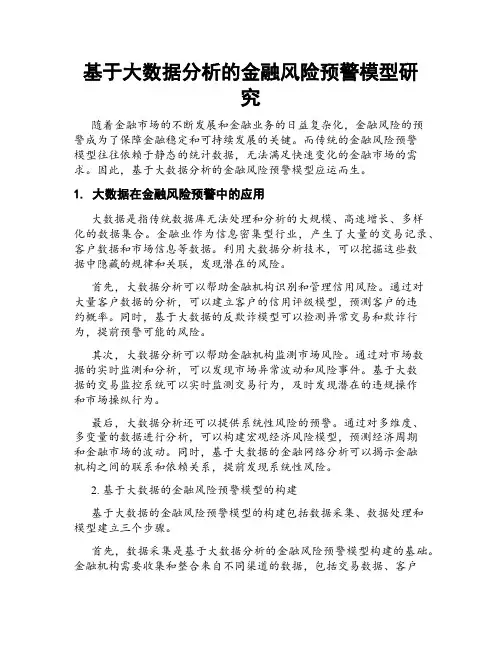
基于大数据分析的金融风险预警模型研究随着金融市场的不断发展和金融业务的日益复杂化,金融风险的预警成为了保障金融稳定和可持续发展的关键。
而传统的金融风险预警模型往往依赖于静态的统计数据,无法满足快速变化的金融市场的需求。
因此,基于大数据分析的金融风险预警模型应运而生。
1. 大数据在金融风险预警中的应用大数据是指传统数据库无法处理和分析的大规模、高速增长、多样化的数据集合。
金融业作为信息密集型行业,产生了大量的交易记录、客户数据和市场信息等数据。
利用大数据分析技术,可以挖掘这些数据中隐藏的规律和关联,发现潜在的风险。
首先,大数据分析可以帮助金融机构识别和管理信用风险。
通过对大量客户数据的分析,可以建立客户的信用评级模型,预测客户的违约概率。
同时,基于大数据的反欺诈模型可以检测异常交易和欺诈行为,提前预警可能的风险。
其次,大数据分析可以帮助金融机构监测市场风险。
通过对市场数据的实时监测和分析,可以发现市场异常波动和风险事件。
基于大数据的交易监控系统可以实时监测交易行为,及时发现潜在的违规操作和市场操纵行为。
最后,大数据分析还可以提供系统性风险的预警。
通过对多维度、多变量的数据进行分析,可以构建宏观经济风险模型,预测经济周期和金融市场的波动。
同时,基于大数据的金融网络分析可以揭示金融机构之间的联系和依赖关系,提前发现系统性风险。
2. 基于大数据的金融风险预警模型的构建基于大数据的金融风险预警模型的构建包括数据采集、数据处理和模型建立三个步骤。
首先,数据采集是基于大数据分析的金融风险预警模型构建的基础。
金融机构需要收集和整合来自不同渠道的数据,包括交易数据、客户数据、市场数据、经济数据等。
同时,还需要利用公开数据、社交媒体数据等非传统数据源,以获取更全面的信息。
其次,数据处理是基于大数据的金融风险预警模型构建的关键。
数据清洗、数据挖掘和数据分析是数据处理的核心环节。
数据清洗是为了去除噪声和异常值,保证数据质量。
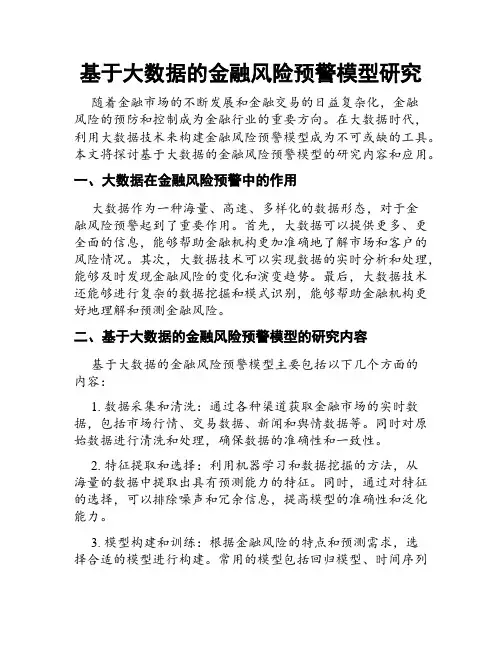
基于大数据的金融风险预警模型研究随着金融市场的不断发展和金融交易的日益复杂化,金融风险的预防和控制成为金融行业的重要方向。
在大数据时代,利用大数据技术来构建金融风险预警模型成为不可或缺的工具。
本文将探讨基于大数据的金融风险预警模型的研究内容和应用。
一、大数据在金融风险预警中的作用大数据作为一种海量、高速、多样化的数据形态,对于金融风险预警起到了重要作用。
首先,大数据可以提供更多、更全面的信息,能够帮助金融机构更加准确地了解市场和客户的风险情况。
其次,大数据技术可以实现数据的实时分析和处理,能够及时发现金融风险的变化和演变趋势。
最后,大数据技术还能够进行复杂的数据挖掘和模式识别,能够帮助金融机构更好地理解和预测金融风险。
二、基于大数据的金融风险预警模型的研究内容基于大数据的金融风险预警模型主要包括以下几个方面的内容:1. 数据采集和清洗:通过各种渠道获取金融市场的实时数据,包括市场行情、交易数据、新闻和舆情数据等。
同时对原始数据进行清洗和处理,确保数据的准确性和一致性。
2. 特征提取和选择:利用机器学习和数据挖掘的方法,从海量的数据中提取出具有预测能力的特征。
同时,通过对特征的选择,可以排除噪声和冗余信息,提高模型的准确性和泛化能力。
3. 模型构建和训练:根据金融风险的特点和预测需求,选择合适的模型进行构建。
常用的模型包括回归模型、时间序列模型、神经网络模型等。
通过训练和优化模型,使其能够对未来的金融风险进行预测和预警。
4. 风险评估和监控:基于构建好的预警模型,对金融市场进行风险评估和监控。
通过与历史数据进行比对和分析,对当前的风险情况进行评估,及时发出预警信号。
5. 预警结果解释和可视化:对预警结果进行解释和可视化展示,帮助金融从业者更加直观地了解风险的来源和变化趋势,做出相应的决策。
三、基于大数据的金融风险预警模型的应用基于大数据的金融风险预警模型已经在金融行业得到了广泛的应用。
以下是一些具体的应用案例:1. 信用风险预警:通过大数据技术,对客户的信用数据进行分析和建模,预测客户的违约概率,提前发出信用风险预警,帮助金融机构降低信用风险损失。
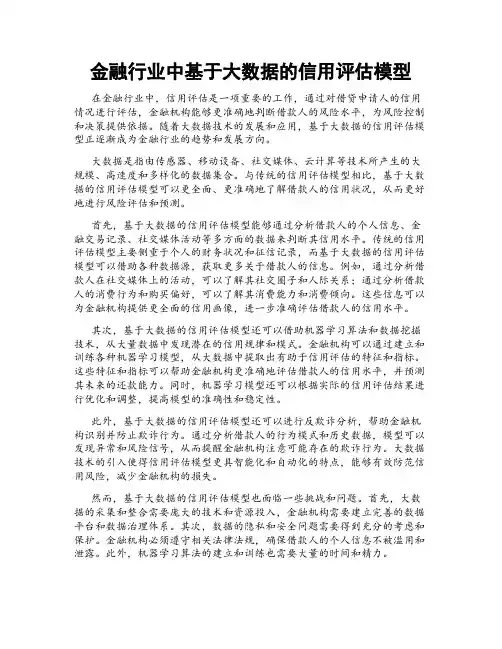
金融行业中基于大数据的信用评估模型在金融行业中,信用评估是一项重要的工作,通过对借贷申请人的信用情况进行评估,金融机构能够更准确地判断借款人的风险水平,为风险控制和决策提供依据。
随着大数据技术的发展和应用,基于大数据的信用评估模型正逐渐成为金融行业的趋势和发展方向。
大数据是指由传感器、移动设备、社交媒体、云计算等技术所产生的大规模、高速度和多样化的数据集合。
与传统的信用评估模型相比,基于大数据的信用评估模型可以更全面、更准确地了解借款人的信用状况,从而更好地进行风险评估和预测。
首先,基于大数据的信用评估模型能够通过分析借款人的个人信息、金融交易记录、社交媒体活动等多方面的数据来判断其信用水平。
传统的信用评估模型主要侧重于个人的财务状况和征信记录,而基于大数据的信用评估模型可以借助各种数据源,获取更多关于借款人的信息。
例如,通过分析借款人在社交媒体上的活动,可以了解其社交圈子和人际关系;通过分析借款人的消费行为和购买偏好,可以了解其消费能力和消费倾向。
这些信息可以为金融机构提供更全面的信用画像,进一步准确评估借款人的信用水平。
其次,基于大数据的信用评估模型还可以借助机器学习算法和数据挖掘技术,从大量数据中发现潜在的信用规律和模式。
金融机构可以通过建立和训练各种机器学习模型,从大数据中提取出有助于信用评估的特征和指标。
这些特征和指标可以帮助金融机构更准确地评估借款人的信用水平,并预测其未来的还款能力。
同时,机器学习模型还可以根据实际的信用评估结果进行优化和调整,提高模型的准确性和稳定性。
此外,基于大数据的信用评估模型还可以进行反欺诈分析,帮助金融机构识别并防止欺诈行为。
通过分析借款人的行为模式和历史数据,模型可以发现异常和风险信号,从而提醒金融机构注意可能存在的欺诈行为。
大数据技术的引入使得信用评估模型更具智能化和自动化的特点,能够有效防范信用风险,减少金融机构的损失。
然而,基于大数据的信用评估模型也面临一些挑战和问题。
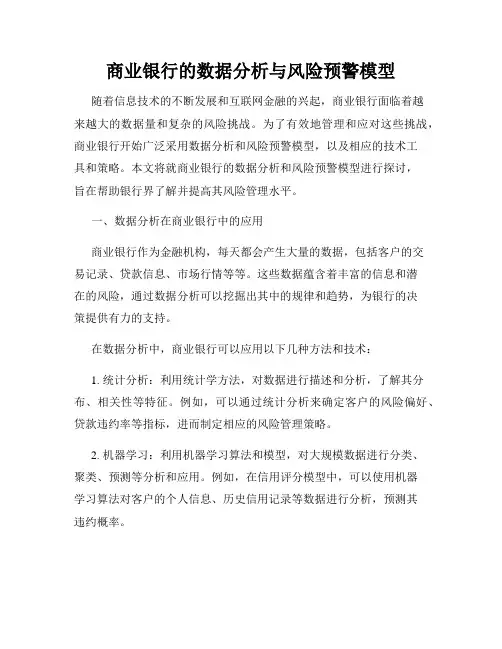
商业银行的数据分析与风险预警模型随着信息技术的不断发展和互联网金融的兴起,商业银行面临着越来越大的数据量和复杂的风险挑战。
为了有效地管理和应对这些挑战,商业银行开始广泛采用数据分析和风险预警模型,以及相应的技术工具和策略。
本文将就商业银行的数据分析和风险预警模型进行探讨,旨在帮助银行界了解并提高其风险管理水平。
一、数据分析在商业银行中的应用商业银行作为金融机构,每天都会产生大量的数据,包括客户的交易记录、贷款信息、市场行情等等。
这些数据蕴含着丰富的信息和潜在的风险,通过数据分析可以挖掘出其中的规律和趋势,为银行的决策提供有力的支持。
在数据分析中,商业银行可以应用以下几种方法和技术:1. 统计分析:利用统计学方法,对数据进行描述和分析,了解其分布、相关性等特征。
例如,可以通过统计分析来确定客户的风险偏好、贷款违约率等指标,进而制定相应的风险管理策略。
2. 机器学习:利用机器学习算法和模型,对大规模数据进行分类、聚类、预测等分析和应用。
例如,在信用评分模型中,可以使用机器学习算法对客户的个人信息、历史信用记录等数据进行分析,预测其违约概率。
3. 数据挖掘:基于大数据技术和算法,挖掘潜在的关联规则、异常模式等信息。
例如,商业银行可以通过数据挖掘技术来发现客户的交易行为异常,从而及时采取相应的风险控制措施。
4. 可视化分析:利用图表、图像等可视化技术,将数据结果以直观的方式展示出来,方便分析师和决策者理解和使用。
例如,可以用数据可视化来展示风险事件的时间、地点、规模等,帮助银行管理和监控风险。
二、风险预警模型在商业银行中的应用风险预警模型是商业银行风险管理的重要工具,通过对不同类型的风险进行分析和预测,帮助银行及时识别风险、预警风险,并采取相应的措施进行防范。
以下是几种常见的风险预警模型:1. 资产质量预警模型:主要用于预测贷款违约的概率,帮助银行评估贷款的风险水平。
该模型通常基于客户的个人信息、还款历史等指标,通过一系列算法和模型进行分析和预测。
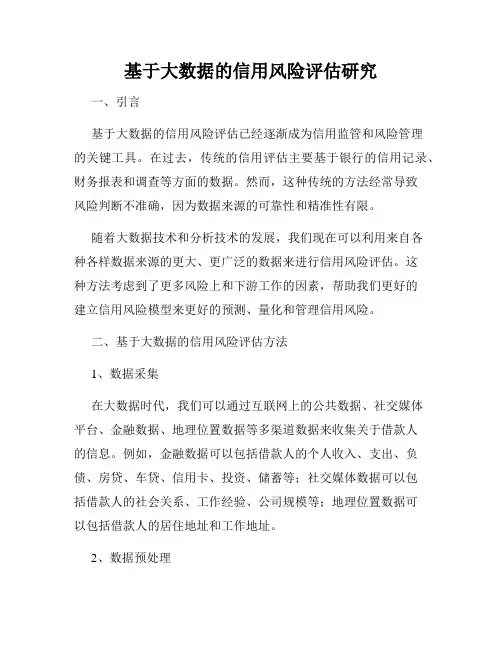
基于大数据的信用风险评估研究一、引言基于大数据的信用风险评估已经逐渐成为信用监管和风险管理的关键工具。
在过去,传统的信用评估主要基于银行的信用记录、财务报表和调查等方面的数据。
然而,这种传统的方法经常导致风险判断不准确,因为数据来源的可靠性和精准性有限。
随着大数据技术和分析技术的发展,我们现在可以利用来自各种各样数据来源的更大、更广泛的数据来进行信用风险评估。
这种方法考虑到了更多风险上和下游工作的因素,帮助我们更好的建立信用风险模型来更好的预测、量化和管理信用风险。
二、基于大数据的信用风险评估方法1、数据采集在大数据时代,我们可以通过互联网上的公共数据、社交媒体平台、金融数据、地理位置数据等多渠道数据来收集关于借款人的信息。
例如,金融数据可以包括借款人的个人收入、支出、负债、房贷、车贷、信用卡、投资、储蓄等;社交媒体数据可以包括借款人的社会关系、工作经验、公司规模等;地理位置数据可以包括借款人的居住地址和工作地址。
2、数据预处理对于从多种数据源中收集来的大量数据,首先需要进行预处理,以确保数据是可用的、准确的并且是的一致性和完整性。
预处理过程包括数据清洗、数据集成、数据推断、数据聚合、数据规范化、数据抽样等环节,这些步骤的目的是处理多个来源的数据来源以获取有关借款人的一致且准确的数据。
3、特征工程特征工程是机器学习中一个重要的预处理步骤,主要目的是通过选择、转换和组合大量数据特征,使数据更加容易被机器学习算法所使用。
在信用风险评估中,特征工程可以包括数据预处理和数据降维,并使用特定算法来构建和选择特征。
4、建立大数据模型利用前面预处理的数据和特征工程实现的特征,可以建立各种大数据模型,如支持向量机、随机森林、神经网络等。
这些模型可以在使用大量数据情况下,建立更准确的信用评估模型,从而使风险管理更为精细、客观和可靠。
5、评估模型和风险管理建立信用风险评估模型后,需要对模型进行评估并根据这些评估结果进行风险管理。
基于大数据的信贷风险评估模型近年来,随着互联网和金融的快速发展,金融科技(FinTech)方兴未艾,而基于大数据的信贷风险评估模型成为了金融机构、银行等金融机构最为关注的问题之一。
本文将就基于大数据的信贷风险评估模型作一探讨。
一、大数据在信贷风险评估中的应用随着数据时代的到来,以及金融市场的竞争日趋激烈,借贷市场也呈现出蓬勃发展的态势。
但同时,随之而来的风险问题也让众多机构深感头疼。
如何通过精细化的风险评估,减少坏账率,成为各机构面临的共性问题。
大数据技术作为支撑信贷决策的技术手段之一,正逐渐成为行业标配之一。
大数据的支持下,信贷机构可以更加方便快捷地获取难以被发现的个人信用信息,排查潜在的欺诈倾向,减少不良拖欠率,并通过应用模型来实现更高效的分析和决策。
有趣的是,通过数据科学的应用,甚至可以创造新的信用评估方法,帮助机构提早经营风险,从而保障其利润。
二、基于大数据的信贷风险评估模型的构建基于大数据技术的信贷风险评估通常从数据的采集、建模、评估三个阶段入手。
对于数据的收集,不同机构存在区别。
比如银行不仅可以利用自身业务数据,进行分析和挖掘用户行为,还可以使用外部数据,如白骑士的征信信息,盘综外部数据来源等,以期获取精准而全面的数据信息。
在建模过程中,需要确立合适的评估周期、评估标准和评估参数,进行风险分析。
此时,大量的数据处理工具可以快速地建立数据,包括金融数据挖掘、机器学习、数据分析等,并以此为依据,生成相应的成果。
常用的建模方法包括回归、决策树、神经网络、支持向量机、聚类等。
以上算法根据不同的数据集和应用背景选用,可以分别得到有监督和无监督分类模型。
最终,评估是根据借款人加减分值来确定其财务状况的预测结果。
评估结果可以是拒贷、授权额度、借贷款利率或相关费用等,也会根据所在机构的实际需求或者依据规则定制化。
因此,好评估的质量决定了机构的长远利益和生存空间。
三、基于大数据的信贷风险评估模型的优势相对传统的信用评估模型,基于大数据技术的信贷风险评估模型具有以下的优势:1. 预测准确性高: 大数据技术可以收集多维度的数据,分析出与信用相关的重要指标,通过自动化、快速的分析,可以预测出借款人未来的信用违约概率。
基于大数据分析的个人信用评估模型研究个人信用评估是近年来在金融领域中备受关注的话题。
随着互联网和移动支付的普及,个人信用评估成为了金融机构和企业判断个人商业信用的重要依据之一。
而在大数据时代的到来下,利用大数据分析技术来构建个人信用评估模型已经成为现实。
在过去,个人信用评估主要依赖于征信机构的数据,比如银行征信报告和信用卡记录。
然而,这种传统的评估方式存在着信息不对称的问题,很难全面准确地评估个人的信用。
而大数据分析技术的应用可以解决这一问题,通过收集和分析大量的数据来综合评估个人的信用状况。
首先,大数据分析可以通过提取多源异构数据并进行关联分析,更全面准确地了解个人的信用状况。
除了传统的贷款和信用卡数据,大数据分析还可以利用个人的社交媒体数据、手机通讯数据、消费记录等多种数据来源。
通过对这些数据的整合和分析,可以建立更全面的个人信用档案,并更准确地了解个人的还款能力、还款意愿等信用相关要素。
其次,大数据分析可以通过机器学习和数据挖掘算法来构建个人信用评估模型,从而进行信用评分。
通过对历史数据的分析,可以发现个人信用状况与不同因素之间的关联规律,建立起预测模型。
这些模型可以根据不同的特征权重,为每个个人生成一个信用评分,用于评估其信用水平。
同时,由于数据分析技术的进步,这些模型也可以不断地进行迭代和优化,提高评估的准确性。
此外,大数据分析还可以通过实时监控和预警系统来提供个人的风险评估。
利用大数据分析技术,可以及时监控个人的行为模式和信用动态,发现潜在的风险,并通过预警系统及时采取措施。
这种实时的风险评估可以有效地预防欺诈行为和信用风险,保障金融机构和企业的利益。
然而,构建基于大数据分析的个人信用评估模型也面临着一些挑战和难题。
首先是数据隐私和安全问题。
由于个人信用评估需要收集和使用大量的个人数据,如何保护个人隐私成为了一个重要的问题。
金融机构和企业需要建立起严格的数据保护机制,以确保个人数据的安全和隐私。
基于大规模数据的信用评级与评估模型研究信用评级与评估模型是金融领域中非常重要且不可或缺的工具。
随着互联网和大数据技术的不断发展,基于大规模数据的信用评级与评估模型也逐渐成为业界的研究热点。
本文将围绕这一主题展开,探讨基于大规模数据的信用评级与评估模型研究的现状、方法和应用前景。
首先,我们需要明确信用评级与评估模型的概念及其重要性。
信用评级是指对借款人或发行人的信用风险进行评估,并以一定的等级体系表示出来。
信用评级通过评估借款人或发行人偿还债务的能力和意愿,帮助投资者做出投资决策。
评估模型是用来预测和衡量借款人或发行人的信用状况的数学模型。
准确的信用评级和评估模型可以帮助金融机构降低信用风险,提高借贷效率。
在大数据时代,我们可以利用大规模数据进行信用评级与评估模型的研究。
大数据技术可以帮助我们获取更加全面、精准的数据,包括借款人的个人信息、交易记录、信用历史等等。
通过分析这些数据,我们可以建立更加准确、可靠的信用评级与评估模型。
与传统的基于小样本数据的评估模型相比,基于大规模数据的信用评级与评估模型具有更高的准确性和稳定性。
基于大规模数据的信用评级与评估模型的研究方法有很多种,常用的方法包括机器学习、数据挖掘和统计分析等。
机器学习是通过训练算法来识别模式并进行预测的一种方法。
在信用评级与评估模型中,我们可以通过机器学习算法来发现影响信用状况的关键因素,并建立预测模型。
数据挖掘是从大规模数据中发现并提取有用信息的过程,可以帮助我们发现借款人的行为模式和信用特点。
统计分析则可以帮助我们分析借款人的信用历史和信用状况之间的关系,并建立相应的评估模型。
这些方法可以相互结合,以提高预测的准确性和可靠性。
基于大规模数据的信用评级与评估模型在金融行业中有着广泛的应用前景。
首先,它可以帮助银行和其他金融机构降低信用风险,减少不良贷款的数量。
通过提高信用评级与评估模型的准确性,金融机构可以更加精准地对借款人进行风险评估和信用评级。
基于大数据的风险管理模型与实践随着信息技术的快速发展,大数据的应用已经渗透到各个行业,并对企业风险管理提供了新的思路和解决方案。
本文将介绍基于大数据的风险管理模型和实践,以帮助企业更好地应对和管理风险。
大数据风险管理模型的构建是基于大数据技术和风险管理理论的结合。
其中,大数据技术扮演着收集、存储和分析大量数据的角色,而风险管理理论则为企业提供了有关风险定义、分类、评估和应对的框架。
综合应用这两者可以帮助企业更准确地识别和评估风险,并制定相应的应对策略。
在大数据风险管理模型中,数据的收集和分析是核心环节。
企业可以通过各种传感设备、传感器和软件系统收集海量的数据,包括客户信息、交易数据、运营数据等。
这些数据可以来自内部系统,也可以来自外部市场和社交媒体等渠道。
同时,数据分析技术也是至关重要的。
企业可以运用数据挖掘、机器学习等技术对收集到的数据进行深度分析,以发现其中潜在的风险和模式。
在风险分类和评估方面,大数据风险管理模型可以帮助企业更全面地理解和评估各种风险。
传统的风险管理更侧重于财务和市场风险,而大数据风险管理模型可以包括更多维度的风险,如供应链风险、运营风险、合规风险等。
通过整合和分析各个维度的数据,企业可以更好地了解潜在风险的来源和影响,并为其制定相应的防范策略。
此外,大数据风险管理模型还可以通过实时监测和预警系统来提高风险的控制能力。
传统的风险管理模型通常是基于历史数据或定期的报告,无法实时反映风险的变化。
而大数据风险管理模型可以通过实时收集和分析数据,及时发现和响应突发风险。
例如,企业可以建立实时监测系统来跟踪市场趋势,预警系统来监测供应链风险,以便在出现风险事件时能够及时采取相应措施,减少损失。
除了理论模型,大数据风险管理的实践案例也在不同行业中得到了广泛应用。
以金融行业为例,银行通过分析客户交易数据和行为模式,可以评估客户的信用风险,并制定相应的信贷策略。
保险公司可以通过分析历史数据和预测模型来评估保险事故的概率,以确保保费的定价和赔付的公正性。
基于大规模数据的风险预测模型背景在现代社会中,风险管理已成为企业、政府和个人生活的重要组成部分。
为有效地控制风险,许多机构不断尝试基于大规模数据实现风险预测。
这就需要建立一种可靠、精准的模型来预测风险,从而提高风险管理的效率和准确性。
风险预测模型的分类和应用风险预测模型可根据使用的数据类型和方法的不同分为以下几类:1.基于统计学方法的模型。
这种模型通过利用历史数据和统计学方法进行分析,来预测未来事件的可能性。
比如金融领域中的VaR(value at risk)模型、信用评分模型等。
2.基于机器学习方法的模型。
这种模型通过利用大量数据,运用机器学习算法进行训练和学习,来预测未来事件的可能性。
常用的机器学习方法包括神经网络、支持向量机、决策树等。
这种模型被广泛应用于保险、银行、医疗等领域。
3.基于深度学习方法的模型。
这种模型是机器学习的一种变体,可以通过对大规模数据的分析和学习,从而得出高精度的预测结果。
常用的深度学习方法包括卷积神经网络、循环神经网络等。
这种模型被广泛应用于图像识别、自然语言处理、语音识别等领域。
案例研究:基于机器学习的大规模数据风险预测模型以银行信贷为例,构建一个基于机器学习方法的大规模数据风险预测模型。
具体步骤如下:1.数据收集。
收集与信贷相关的大规模数据,包括客户基本信息、过往贷款情况、家庭状况、职业状况等。
2.数据处理。
将收集到的大量数据进行筛选、清洗和特征提取,得到能够描述客户信用状况的特征向量。
3.模型训练。
采用常用的机器学习算法,如随机森林、逻辑回归、支持向量机等,通过对特征向量进行训练,得到一个客户信用评级模型。
4.模型验证。
将训练好的模型应用于新数据中,验证模型的准确性和泛化能力。
5.模型调优。
根据验证结果,对模型进行调优和改进,使其更加准确和可靠。
通过以上步骤,我们能够得到一个基于机器学习方法的大规模数据风险预测模型,能够更加准确地评估客户的信用风险,提高银行的风险管理水平。
基于大数据分析的信用评估模型研究随着大数据技术的发展和普及,越来越多的机构和企业开始将大数据应用于信用评估模型的研究中。
这种基于大数据分析的信用评估模型可以更准确、更客观地评估个人或企业的信用状况,为金融机构、企业和个人提供更精准的信用服务。
一、大数据分析在信用评估中的应用价值信用评估是评估个人或企业在贷款和信贷交易中的信用风险以及偿还能力的过程。
传统的信用评估模型往往基于规则和经验判断,具有主观性和片面性的特点,无法全面、客观地评估个人或企业的信用状况。
而基于大数据分析的信用评估模型基于海量的数据和先进的算法,能够全面分析个人或企业的信用状况。
通过对个人或企业的历史数据、社交网络数据、行为数据等进行分析,可以更准确地预测个人或企业的信用状况。
这种模型可以减少主观性和片面性的判断,提高信用评估的准确性和有效性。
二、基于大数据分析的信用评估模型的核心思想基于大数据分析的信用评估模型的核心思想是通过收集和分析个人或企业的大量数据,建立个人或企业的信用档案,从而对个人或企业的信用状况进行评估。
这个信用档案包括个人或企业的基本信息、经济状况、支付记录、社交网络活动等方面的数据。
在建立信用档案的过程中,模型会根据个人或企业的历史数据进行分析,并利用机器学习和人工智能技术来建立信用评估模型。
模型会使用聚类分析、关联规则挖掘、异常检测、决策树等技术来发现个人或企业的信用行为模式,并根据这些模式进行信用评估。
三、基于大数据分析的信用评估模型的关键技术1. 数据收集和预处理技术:信用评估模型需要收集个人或企业的数据,包括个人信息、经济情况、支付记录等。
这些数据可能来自于公开的数据库、金融机构的交易记录、社交平台的数据等。
在收集数据之后,模型需要对数据进行预处理,包括数据清洗、数据整理和数据标准化等过程,以提高后续分析的准确性和可靠性。
2. 特征选择和降维技术:在建立信用评估模型之前,需要选择合适的特征来描述个人或企业的信用状况。
Statistics and Application 统计学与应用, 2020, 9(4), 582-592Published Online August 2020 in Hans. /journal/sahttps:///10.12677/sa.2020.94062User Credit Risk Prediction Modelbased on Big DataJingwen Hu, Xiao Liu, Zhe FengSchool of Mathematical Science, Tongji University, ShanghaiReceived: Jul. 16th, 2020; accepted: Jul. 28th, 2020; published: Aug. 5th, 2020AbstractCredit risk is the main risk of bank operation and affects the development of bank. It is necessary to establish credit risk prediction model to help banks avoid risks and reduce losses. In this paper, 80,000 pieces of thousand dimensional data of a commercial bank are taken as the research object, and the method of “group principal component” is used to preprocess the data of thousand dimen-sional variables. Then, the credit risk prediction model is established by using Logistic regression and random forest respectively. The analysis results of the two models show that the customer’s credit card level, occupation, value level, basic information of personal business, deposits and for-eign current holdings have great influence on predicting the probability of default. The area under the curve of logistic regression model is 0.847, and the prediction accuracy is 75%; the area under the curve of the random forest model is 0.848, and the prediction accuracy is 85%. Compared with previous studies, the prediction accuracy of the two models is significantly improved. In practical application, the two models can be combined with each other to give full play to their advantages.KeywordsCredit Risk, Principal Component Analysis, Logistic Regression Model, Random Forest Model, High Dimensional Data基于银行大数据的用户信用风险预测模型胡竞文,刘潇,冯哲同济大学,数学科学学院,上海收稿日期:2020年7月16日;录用日期:2020年7月28日;发布日期:2020年8月5日摘要信用风险是银行经营的主要风险,影响银行的发展,有必要建立信用风险预测模型,帮助银行规避风险、胡竞文等减少损失。
本文以某家商业银行的八万条千维数据作为研究对象,采用“分组主成分”的方法对千维变量进行降维的数据预处理,运用Logistic回归和随机森林建立信用风险预测模型。
两种模型的分析结果显示,客户的信用卡级别、职业、价值等级、个人业务基本情况、存款及本外币持有额情况对违约风险预测的影响较大。
Logistic回归曲线下面积为0.847,预测准确率为75%;随机森林曲线下面积为0.848,预测准确率为85%,相较于以往的研究,两个模型的预测准确率都有明显提高。
实际应用时,两种模型可以相互结合,充分发挥二者的优越性。
关键词信用风险,主成分分析,Logistic回归模型,随机森林模型,高维数据Copyright © 2020 by author(s) and Hans Publishers Inc.This work is licensed under the Creative Commons Attribution International License (CC BY 4.0)./licenses/by/4.0/1. 引言银行经营的过程会面临许多风险,其中信用风险是主要风险。
信用风险的涵义是,因为债务人未能按合约执行义务,或信用质量改变,给债权人带来损失的可能性。
信用风险会给银行带来直接或间接的经济损耗、增加管理成本、降低资金利用率[1]。
因此,建立风险预测模型,根据客户数据信息,预测是否可能违约,有助于银行控制风险、减少损失、保证收益。
信用风险预测模型一直被持续而广泛地研究,信用风险预测研究的主要模型如表1。
Table 1. Main models of credit risk prediction表1.信用风险预测研究的主要模型非线性模型广义线性模型机器学习模型非参数模型线性判别分析模型神经网络模型样条回归模型(Linear Discriminant Analysis, LDA) (Neural Networks, NN) (Spline Regression Models) Probit回归模型支持向量机模型核回归(Probit Regression) (Support Vector Machine, SVM) (Kernel Regression)Logistic回归模型决策树模型局部多项式回归(Logistic Regression) (Decision Tree) (Local Polynomial Regression)随机森林模型(Random Forest)例如,庞素琳[2]等用线性判别分析方法建立企业信用评价模型,对我国2000年106家上市公司进行分析,选取4个指标,预测准确率达到95.28%。
迟国泰[3]等基于某商业银行1231笔小企业贷款数据,选取81个指标,用Probit模型建立债信评级模型,预测准确率达到60%。
Milad Malekipirbazari [4]等基于社交借贷平台的数据,选择23个变量,用随机森林、SVM、Logistic等模型预测信用风险,预测准确率随机森林88%,SVM47%,Logistic49 %。
Sidney Tsang [5]等用神经网络、决策树等模型,针对4000个欺诈行为数据,选择10个变量进入模型,准确率分别达到84.7%、96.7%。
陈为民[6]根据客户消费行胡竞文等为数据,使用多元自适应样条回归建立信用欺诈监测模型,用长沙某银行的2000条信用卡数据做实证研究,每个客户有15个属性,预测准确率达到83.91%。
这些模型较易理解,能较准确地预测违约状态。
然而,已有的运用这些模型进行风险预测的研究,多基于数据量一万以内、变量不超过100的数据,对于数据结构复杂的高维数据,讨论并不充分。
而在处理大批量的高维数据时,这些模型都存在各自的缺点。
实际数据中,解释变量与违约状态可能并非线性或广义线性关系,广义线性模型无法处理非线性数据,容易欠拟合,一般准确率不高。
机器学习模型虽然能较准确的预测违约状态,却不能得出相应的显示表达式,可解释性较差[7]。
进一步,与传统的机器学习算法相比,神经网络、支持向量机在数据样本很多时运算效率较低;单个决策树模型相比于随机森林模型精确度较低。
非参数模型虽然灵活且强大,但往往需要更多的数据、更长的训练时间,而结果是更容易过拟合,解释性更差。
本文基于一份我国2019年某家商业银行的客户信息数据,这份数据包含80,000条数据,986个变量,近千维的数据在已有的文献中是鲜有存在的,如果直接使用上述模型方法,不仅可能由于算法过于复杂无法得出模型结果,进入模型的变量过多还会导致模型的稳定性很差,可能引发“维度灾难”[8]。
数据是建立模型的基础,对于高维复杂数据,数据预处理是提高模型稳定性、提高模型拟合精度的重要环节。
因此本文首先对原始数据进行筛选、转换,通过主成分分析、重编码等方式,大大降低数据维数。
结合数据样本的变量类型以及样本大小,决定采用Logistic回归和随机森林算法构建信用风险预测模型,为银行控制信用风险提供科学依据。
本文的模型方法适应大样本,稳定性好、可推广、运算效率高。
同时,模型对信用风险的预测效果好,结果显示两种模型预测准确率分别达到75%和85%,相较于张婷婷(2017)用Logistic回归模型评估个人信用评分,预测违约状态准确率为67.62% [9],张亚琴(2019)基于集成学习的方法研究信用风险预测,随机森林模型预测准确率为77.1% [10],本文建立的模型预测准确率提高。
且Logistic回归模型与随机森林模型相结合,既发挥Logistic回归的可解释性优势,也发挥随机森林的高准确率优势。
2. 数据概述本文所分析的数据是来自某家商业银行的客户信息[11],共包含80,000条数据,986个变量,其中数值型变量944个,字符型变量42个。
数值型变量经整理后,根据含义划分为17组,见表2,字符型变量见表3。
Table 2. Numerical explanatory variable表2.数值型解释变量变量名称变量个数变量具体情况个人业务基本情况110 77个连续型,32个离散型,1个取值常数存款及本外币持有额91 55个连续型,21个离散型,15个取值常数柜台业务112 65个连续型,41个离散型,6个取值常数网银业务88 46个连续型,30个离散型,12个取值常数电话业务71 24个连续型,25个离散型,22个取值常数手机银行业务60 34个连续型,26个离散型网络银行业务20 14个连续型,6个离散型自助设备业务68 40个连续型,16个离散型,12个取值常数乐收银POS机业务48 30个连续型,14个离散型,4个取值常数胡竞文等Continued本行POS机业务40 25个连续型,10个离散型,5个取值常数它行POS机业务40 27个连续型,10个离散型,3个取值常数其他业务22 14个连续型,6个离散型大额业务32 4个连续型,4个离散型,24个取值常数信用卡业务26 10个连续型,10个离散型,6个取值常数定期存款业务20 13个连续型,7个离散型理财产品业务33 26个连续型,7个离散型基金业务63 49个连续型,12个离散型,2个取值常数Table 3. Character explanatory variable表3.字符型解释变量变量名称变量个数变量具体情况客户号 1 8位字符开户机构 1 4位编码证件类型 1 4位编码性别 1 取值1、2客户价值等级 1 取值A、B、C职业 1 取值1-5是否型变量21 包括是否有欧元账户、是否有澳元账户、是否薪资理财等持有标志型变量15 包括持有活期产品标志、持有定期存款标志、个贷标识等3. 建模方法本批数据变量数量庞大,不仅大大增加了计算的负担,而且信息重复导致变量间存在共线性,对后续建立模型分析会造成严重后果。